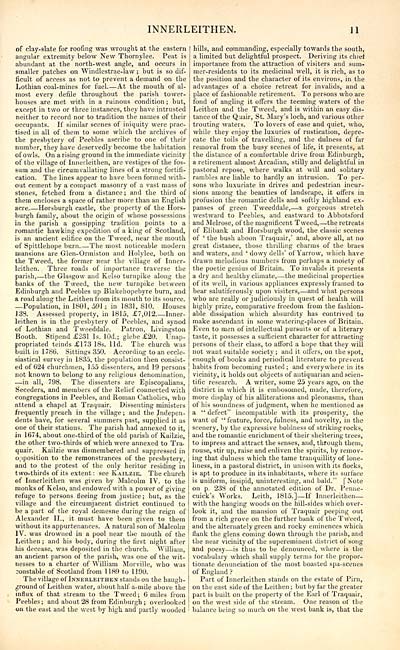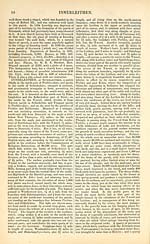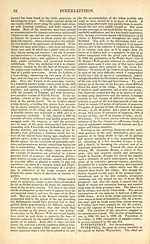Download files
Complete book:
Individual page:
Thumbnail gallery: Grid view | List view

INNERLEITHEN.
11
of clay-slate for roofing was wrought at the eastern
angular extremity below New Thornylee. Peat is
abundant at the north-west angle, and occurs in
smaller patches on Windlestrae-law ; but is so dif-
ficult of access as not to prevent a demand on the
Lothian coal-mines for fuel At the mouth of al-
most every defile throughout the parish tower-
houses are met with in a ruinous condition; but,
except in two or three instances, they have intrusted
neither to record nor to tradition the names of their
occupants. If similar scenes of iniquity were prac-
tised in all of them to some which the archives of
the presbytery of Peebles ascribe to one of their
number, they have deservedly become the habitation
of owls. On a rising ground in the immediate vicinity
of the village of Innerleithen, are vestiges of the fos-
sum and the circumvallating lines of a strong fortifi-
cation. The lines appear to have been formed with-
out cement by a compact masonry of a vast mass of
stones, fetched from a distance; and the third of
them encloses a space of rather more than an English
acre Horsburgh castle, the property of the Hors-
burgh family, about the origin of whose possessions
in the parish a gossipping tradition points to a
romantic hawking expedition of a king of Scotland,
is an ancient edifice on the Tweed, near the mouth
of Spittlehope burn The most noticeable modern
mansions are Glen-Ormiston and Holylee, both on
the Tweed, the former near the village of Inner-
leithen. Three roads of importance traverse the
parish, — the Glasgow and Kelso turnpike along the
banks of the Tweed, the new turnpike between
Edinburgh and Peebles up Blakebopebyre burn, and
a road along the Leithen from its mouth to its source.
—Population, in 1801, 591 ; in 1831, 810. Houses
133. Assessed property, in 1815, £7,012 Inner-
leithen is in the presbytery of Peebles, and synod
of Lothian and Tweeddale. Patron, Livingston
Booth. Stipend £231 Is. 10d.; glebe £20. Unap-
propriated teinris £173 18s. lid. The church was
built in 1786. Sittings 350. According to an eccle-
siastical survey in 1835, the population then consist-
ed of 624 churchmen, 15.5 dissenters, and 19 persons
not known to belong to any religious denomination,
— in all, 798. The dissenters are Episcopalians,
Seceders, and members of the Relief connected with
congregations in Peebles, and Roman Catholics, who
attend a ehapel at Traquair. Dissenting ministers
frequently preach in the village ; and the Indepen-
dents have, for several summers past, supplied it as
one of their stations. The parish had annexed to it,
in 1674, about one-third of the old parish of Kailzie,
the other two-thirds of which were annexed to Tra-
quair. Kailzie was dismembered and suppressed in
opposition to the remonstrances of the presbytery,
and to the protest of the only heritor residing in
two-thirds of its extent : see Kailzie. The church
of Innerleithen was given by Malcolm IV. to the
monks of Kelso, and endowed with a power of giving
refuge to persons fleeing from justice; but, as the
village and the circumjacent district continued to
be a part of the royal demesne during the reign of
Alexander II., it must have been given to them
without its appurtenances. A natural son of Malcolm
IV. was drowned in a pool near the mouth of the
Leithen ; and his body, during the first night after
his decease, was deposited in the church. William,
an ancient parson of the parish, was one of the wit-
nesses to a charter of William Morville, who was
zonstable of Scotland from 1 189 to U90.
The village of Innerleithen stands on the haugh-
ground of Leithen water, about half- a-mile above the
influx of that stream to the Tweed; 6 miles from
Peebles; and about 28 from Edinburgh ; overlooked
on the east and the west by high and partly wooded
hills, and commanding, especially towards the south,
a limited but delightful prospect. Deriving its chief
importance from the attraction of visiters and sum-
mer-residents to its medicinal well, it is rich, as to
the position and the character of its environs, in the
advantages of a choice retreat for invalids, and a
place of fashionable retirement. To persons who are
fond of angling it offers the teeming waters of the
Leithen and the Tweed, and is within an easy dis-
tance of the Quair, St Mary's loch, and various other
trouting waters. To lovers of ease and quiet, who,
while they enjoy the luxuries of rustication, depre-
cate the toils of travelling, and the dulness of far
removal from the busy scenes of life, it presents, at
the distance of a comfortable drive from Edinburgh,
a retirement almost Arcadian, stilly and delightful in
pastoral repose, where walks at will and solitary
rambles are liable to hardly an intrusion. To per-
sons who luxuriate in drives and pedestrian incur-
sions among the beauties of landscape, it offers in
profusion the romantic dells and softly highland ex-
panses of green Tweeddale, — a gorgeous stretch
westward to Peebles, and eastward to Abbotsford
and Melrose, of the magnificent Tweed, — the retreats
of Elibank and Horsburgh wood, the classic scenes
of ' the bush aboon Traquair,' and, above all, at no
great distance, those thrilling charms of the braes
and waters, and ' dowy dells' of Yarrow, which have
drawn melodious numbers from perhaps a moiety of
the poetic genius of Britain. To invalids it presents
a dry and healthy climate, — the medicinal properties
of its well, in various appliances expressly framed to
bear salutiferously upon visiters, — and what persons
who are really or judiciously in quest of health will
highly prize, comparative freedom from the fashion-
able dissipation which absurdity has contrived to
make ascendant in some watering-places of Britain.
Even to men of intellectual pursuits or of a literary
taste, it possesses a sufficient character for attracting
persons of their class, to afford a hope that they will
not want suitable society ; and it offers, on the spot,
enough of books and periodical literature to prevent
habits from becoming rusted; and everywhere in its
vicinity, it holds out objects of antiquarian and scien-
tific research. A writer, some 25 years ago, on the
district in which it is embosomed, made, therefore,
more display of his alliterations and pleonasms, than
of his soundness of judgment, when he mentioned as
a " defect" incompatible with its prosperity, the
want of "feature, force, fulness, and novelty, in the
scenery, by the expressive boldness of striking rocks,
and the romantic enrichment of their sheltering trees,
to impress and attract the senses, and, through them,
rouse, stir up, raise and enliven the spirits, by remov-
ing that dulness which the tame tranquillity of lone-
liness, in a pastoral district, in unison with its flocks,
is apt to produce in its inhabitants, where its surface
is uniform, insipid, uninteresting, and bald." ("Note
on p. 233 of the annotated edition of Dr. Penne-
cuick's Works. Leith, 1815.] — If Innerleithen —
with the hanging woods on the hill-sides which over-
look it, and the mansion of Traquair peeping out
from a rich grove on the further bank of the Tweed,
and the alternately green and rocky eminences which
flank the glens coming down through the parish, and
the near vicinity of the supereminent district of song
and poesy — is thus to be denounced, where is the
vocabulary which shall supply terms lor the propor-
tionate denunciation of the most boasted spa-scenes
of England ?
Part of Innerleithen stands on the estate of Pirn,
on the east side of the Leithen ; but by far the greater
part is built on the property of the Earl of Traquair,
on the west side of the stream. One reason of the
balance being so much on the west bank is, that the
11
of clay-slate for roofing was wrought at the eastern
angular extremity below New Thornylee. Peat is
abundant at the north-west angle, and occurs in
smaller patches on Windlestrae-law ; but is so dif-
ficult of access as not to prevent a demand on the
Lothian coal-mines for fuel At the mouth of al-
most every defile throughout the parish tower-
houses are met with in a ruinous condition; but,
except in two or three instances, they have intrusted
neither to record nor to tradition the names of their
occupants. If similar scenes of iniquity were prac-
tised in all of them to some which the archives of
the presbytery of Peebles ascribe to one of their
number, they have deservedly become the habitation
of owls. On a rising ground in the immediate vicinity
of the village of Innerleithen, are vestiges of the fos-
sum and the circumvallating lines of a strong fortifi-
cation. The lines appear to have been formed with-
out cement by a compact masonry of a vast mass of
stones, fetched from a distance; and the third of
them encloses a space of rather more than an English
acre Horsburgh castle, the property of the Hors-
burgh family, about the origin of whose possessions
in the parish a gossipping tradition points to a
romantic hawking expedition of a king of Scotland,
is an ancient edifice on the Tweed, near the mouth
of Spittlehope burn The most noticeable modern
mansions are Glen-Ormiston and Holylee, both on
the Tweed, the former near the village of Inner-
leithen. Three roads of importance traverse the
parish, — the Glasgow and Kelso turnpike along the
banks of the Tweed, the new turnpike between
Edinburgh and Peebles up Blakebopebyre burn, and
a road along the Leithen from its mouth to its source.
—Population, in 1801, 591 ; in 1831, 810. Houses
133. Assessed property, in 1815, £7,012 Inner-
leithen is in the presbytery of Peebles, and synod
of Lothian and Tweeddale. Patron, Livingston
Booth. Stipend £231 Is. 10d.; glebe £20. Unap-
propriated teinris £173 18s. lid. The church was
built in 1786. Sittings 350. According to an eccle-
siastical survey in 1835, the population then consist-
ed of 624 churchmen, 15.5 dissenters, and 19 persons
not known to belong to any religious denomination,
— in all, 798. The dissenters are Episcopalians,
Seceders, and members of the Relief connected with
congregations in Peebles, and Roman Catholics, who
attend a ehapel at Traquair. Dissenting ministers
frequently preach in the village ; and the Indepen-
dents have, for several summers past, supplied it as
one of their stations. The parish had annexed to it,
in 1674, about one-third of the old parish of Kailzie,
the other two-thirds of which were annexed to Tra-
quair. Kailzie was dismembered and suppressed in
opposition to the remonstrances of the presbytery,
and to the protest of the only heritor residing in
two-thirds of its extent : see Kailzie. The church
of Innerleithen was given by Malcolm IV. to the
monks of Kelso, and endowed with a power of giving
refuge to persons fleeing from justice; but, as the
village and the circumjacent district continued to
be a part of the royal demesne during the reign of
Alexander II., it must have been given to them
without its appurtenances. A natural son of Malcolm
IV. was drowned in a pool near the mouth of the
Leithen ; and his body, during the first night after
his decease, was deposited in the church. William,
an ancient parson of the parish, was one of the wit-
nesses to a charter of William Morville, who was
zonstable of Scotland from 1 189 to U90.
The village of Innerleithen stands on the haugh-
ground of Leithen water, about half- a-mile above the
influx of that stream to the Tweed; 6 miles from
Peebles; and about 28 from Edinburgh ; overlooked
on the east and the west by high and partly wooded
hills, and commanding, especially towards the south,
a limited but delightful prospect. Deriving its chief
importance from the attraction of visiters and sum-
mer-residents to its medicinal well, it is rich, as to
the position and the character of its environs, in the
advantages of a choice retreat for invalids, and a
place of fashionable retirement. To persons who are
fond of angling it offers the teeming waters of the
Leithen and the Tweed, and is within an easy dis-
tance of the Quair, St Mary's loch, and various other
trouting waters. To lovers of ease and quiet, who,
while they enjoy the luxuries of rustication, depre-
cate the toils of travelling, and the dulness of far
removal from the busy scenes of life, it presents, at
the distance of a comfortable drive from Edinburgh,
a retirement almost Arcadian, stilly and delightful in
pastoral repose, where walks at will and solitary
rambles are liable to hardly an intrusion. To per-
sons who luxuriate in drives and pedestrian incur-
sions among the beauties of landscape, it offers in
profusion the romantic dells and softly highland ex-
panses of green Tweeddale, — a gorgeous stretch
westward to Peebles, and eastward to Abbotsford
and Melrose, of the magnificent Tweed, — the retreats
of Elibank and Horsburgh wood, the classic scenes
of ' the bush aboon Traquair,' and, above all, at no
great distance, those thrilling charms of the braes
and waters, and ' dowy dells' of Yarrow, which have
drawn melodious numbers from perhaps a moiety of
the poetic genius of Britain. To invalids it presents
a dry and healthy climate, — the medicinal properties
of its well, in various appliances expressly framed to
bear salutiferously upon visiters, — and what persons
who are really or judiciously in quest of health will
highly prize, comparative freedom from the fashion-
able dissipation which absurdity has contrived to
make ascendant in some watering-places of Britain.
Even to men of intellectual pursuits or of a literary
taste, it possesses a sufficient character for attracting
persons of their class, to afford a hope that they will
not want suitable society ; and it offers, on the spot,
enough of books and periodical literature to prevent
habits from becoming rusted; and everywhere in its
vicinity, it holds out objects of antiquarian and scien-
tific research. A writer, some 25 years ago, on the
district in which it is embosomed, made, therefore,
more display of his alliterations and pleonasms, than
of his soundness of judgment, when he mentioned as
a " defect" incompatible with its prosperity, the
want of "feature, force, fulness, and novelty, in the
scenery, by the expressive boldness of striking rocks,
and the romantic enrichment of their sheltering trees,
to impress and attract the senses, and, through them,
rouse, stir up, raise and enliven the spirits, by remov-
ing that dulness which the tame tranquillity of lone-
liness, in a pastoral district, in unison with its flocks,
is apt to produce in its inhabitants, where its surface
is uniform, insipid, uninteresting, and bald." ("Note
on p. 233 of the annotated edition of Dr. Penne-
cuick's Works. Leith, 1815.] — If Innerleithen —
with the hanging woods on the hill-sides which over-
look it, and the mansion of Traquair peeping out
from a rich grove on the further bank of the Tweed,
and the alternately green and rocky eminences which
flank the glens coming down through the parish, and
the near vicinity of the supereminent district of song
and poesy — is thus to be denounced, where is the
vocabulary which shall supply terms lor the propor-
tionate denunciation of the most boasted spa-scenes
of England ?
Part of Innerleithen stands on the estate of Pirn,
on the east side of the Leithen ; but by far the greater
part is built on the property of the Earl of Traquair,
on the west side of the stream. One reason of the
balance being so much on the west bank is, that the
Set display mode to: Large image | Transcription
Images and transcriptions on this page, including medium image downloads, may be used under the Creative Commons Attribution 4.0 International Licence unless otherwise stated. ![]()
| Gazetteers of Scotland, 1803-1901 > Topographical, statistical, and historical gazetteer of Scotland > Volume 2 > (21) Page 11 |
|---|
| Permanent URL | https://digital.nls.uk/97448842 |
|---|
| Description | Volume second: I-Z. |
|---|---|
| Shelfmark | Map Room Ref.2 |
| Attribution and copyright: |
|

